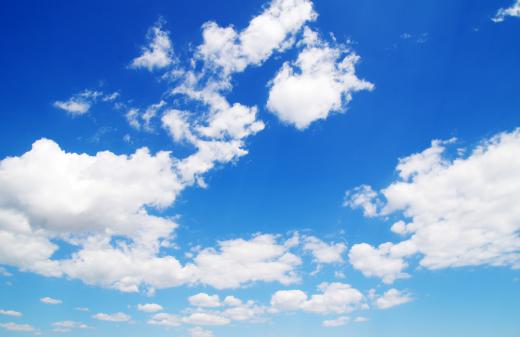What is Condensation?
The process of condensation is the physical change of state of a gas to a liquid. It is the opposite of evaporation, which is the process of a liquid changing into a gas due to it being heated. Most often, condensation is caused by a drop in temperature, although it can also be brought on by compressing the gas. When the gas has condensed, the resulting liquid is referred to as the condensate.
This process causes a physical change, not a chemical one, as the resulting substance is the same as the initial except for its state. Cooling or compressing a vapor causes it to shrink in volume, which causes a reduction in the velocity of the molecules that make up the gas. As the molecules slow down and get closer together, they are more likely to join together. Eventually, enough molecules join together to form droplets of the liquid state of the substance and condense.

Condensation is an important phase of distillation, which is used in laboratories and chemical applications to separate substances within a mixture from one another. Distillation is based on the premise that different substances evaporate and condense at different temperatures. During distillation, the mixture is heated to a specific temperature, causing one of the liquids to boil and evaporate off. Once it is in its gaseous form, it moves through a condenser.

A condenser is commonly a very narrow tube, which causes the gas to be compressed. Not only is the gas compressed, but the area in the condenser is cooler than that over the heat source. The compression and reduced temperature causes the gas to condense back to its liquid form. The resultant liquid, or condensate, is no longer part of the mixture. The condensate can then be collected in its pure form.

Condensation plays a vital role in the water cycle. Water from the Earth enters the atmosphere due to evaporation from the oceans and transpiration from plants. As the water vapor moves higher in the atmosphere, it begins to cool down. As it cools, the vapor begins to condense into liquid form, which causes clouds. When enough liquid water exists in the clouds, it falls back to the Earth as rain or snow, depending on the temperature, starting the cycle again.

In chemistry, substances can be formed through condensation reactions. A condensation reaction occurs when atoms or molecules join together to make a new molecule. As part of this chemical reaction, when the new molecule is formed, a molecule of water, and sometimes alcohol is released, leading to the name of the reaction.
AS FEATURED ON:
AS FEATURED ON:
















Discussion Comments
This really helped me. Simple vocabulary and all, really helpful for young pupils!
Afterall - I know what you mean. Scientific concepts can be difficult to grasp and the best way to understand evaporation and condensation is through a science project.
My daughter understood the concepts much more after she completed a science project. She had to prove that a plant would die if not watered but kept near a sunlight window with a plastic Ziploc bag over the plant and sealed.
Her hypothesis was that the plant could not live without water, but because of condensation water vapor developed that actually gave the plant the water it needed.
This was as a result of the heat trapped in the bag. The trapped moisture actually made the plant thrive. This is the same concept as condensation on windows. She never forgot that lesson.
When I was a little kid, condensation completely confused me. I didn't understand how, for example, a glass of juice could become moist on the outside when I hadn't spilled any of it. Of course, now I understand that, especially in conditions of high humidity, condensation happens to beverages all the time.
Post your comments